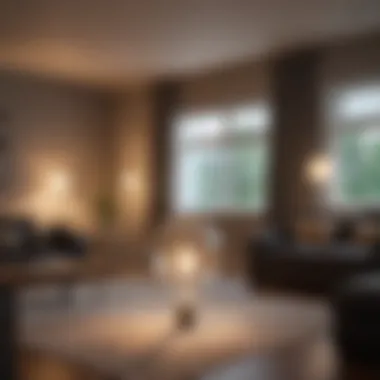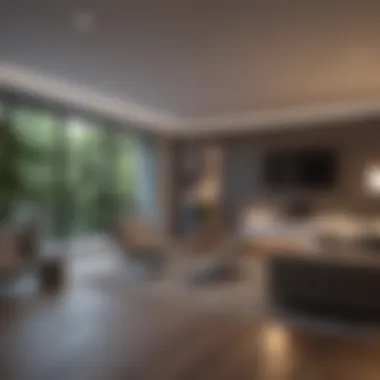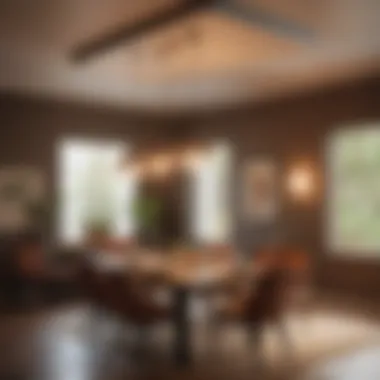Innovations and Trends in Consumer Lighting Solutions


Intro
The realm of consumer lighting has witnessed a significant metamorphosis over the past few decades. Once dominated by the warm flicker of incandescent bulbs, today’s landscape teems with an array of options that cater to diverse preferences and functional needs. In this exploration, we dive into the innovations that have emerged, the trends shaping consumer choices, and the science that underpins these advancements. From the way we illuminate our homes to the broader implications for energy consumption and environmental sustainability, lighting serves as a vital component of our daily lives.
Most people might think of lighting simply as a necessity, but the truth is far more layered. Advances in technology, such as the rapid ascension of LED solutions, have not only improved energy efficiency but have also redefined aesthetics. Thus, each bulb or fixture is not just a matter of illumination; it embodies personal taste and influences the atmosphere within a space. As we embark on this journey, we'll dissect these elements, providing insights for students, researchers, and professionals alike who navigatethe intricacies of consumer lighting.
As we proceed, we will touch upon key points such as:
- Historical progress from traditional bulbs to contemporary LED technology.
- Current trends in design and functionality.
- The impact of lighting options on sustainability and energy use.
- Consumer preferences that drive the market.
- Innovations shaping the future of smart lighting technology.
Understanding consumer lighting is not merely an academic pursuit; it merges functionality with artistry, sustainability with comfort. Each section will build upon the last, crafting a holistic narrative that reveals how the interplay of these components shapes our environments and ultimately, our experiences.
Prolusion to Consumer Lighting
Consumer lighting plays an essential role in shaping the environments where we live, work, and socialize. It's not merely about providing illumination; it’s about enhancing how spaces feel and function. In every facet of contemporary life, from cozy homes to bustling offices, lighting directly affects mood, productivity, and even safety. As we peel back the layers of this critical element in our daily lives, this section will guide you through its definition, scope, and historical context, examining how these aspects collectively influence consumer choices.
Definition and Scope
At its core, consumer lighting refers to the various technologies and styles of lighting systems predominantly used in residential and commercial settings. It encompasses a wide range of products, including traditional incandescent bulbs, energy-efficient fluorescent lights, and the increasingly popular LEDs. The scope of consumer lighting is vast, touching upon various considerations such as aesthetics, functionality, sustainability, and technological integration.
Understanding consumer lighting involves not just knowing the products available, but also recognizing what consumers seek when making choices. Factors such as energy efficiency, design compatibility, and brand reputation can heavily influence purchases. For instance, many individuals today prefer LED lighting for its long lifespan and reduced energy consumption, while also appreciating its modern aesthetic.
Among the benefits of conscious consumer lighting choices are enhanced energy savings, reduced carbon footprints, and improved quality of life through better-lit environments. As consumers become more environmentally aware, there’s a growing expectation for lighting solutions to not only serve practical purposes but also align with sustainable practices.
Historical Context
The evolution of consumer lighting has a rich and fascinating history that reflects broader technological and cultural shifts. Lighting has evolved dramatically over centuries. From the early days of oil lamps and candles to the development of electric lighting in the 19th century, humanity's quest for illumination has been relentless.
The introduction of Thomas Edison’s incandescent bulb in the late 1800s marked a significant turning point. It revolutionized how people illuminated their homes and workplaces. This was followed by the advent of fluorescent lights in the mid-20th century, which offered more efficient alternatives but often came with harsh lighting that many found unappealing.
The modern era introduced LEDs, which significantly changed the game. Not only do they consume far less energy, but they also come in various designs and color temperatures, catering to diverse consumer preferences. With innovations like smart lighting and IoT connections, we stand at the brink of a new revolution that promises even greater advances in consumer lighting.
"Consumer lighting is no longer just about brightness; it’s about crafting experiences that resonate with our lifestyles and values."
Consequently, the discussion around consumer lighting is not just an exploration of different technologies; it's a journey through history that reflects changing societal values and innovations. This historical backdrop provides invaluable insights into current trends and future directions in consumer lighting, making it an essential aspect of our exploration.
Technological Advancements in Lighting
In this ever-evolving world, technological advancements in lighting bear significant impact on how consumers approach illumination in their homes and workplaces. The transition from traditional lighting methods to modern technologies has not only enhanced the quality of light but also improved energy efficiency and user experience. This section delves into the critical breakthroughs that have shaped the consumer lighting landscape, highlighting their implications for sustainability and design aesthetics.
Incandescent to LED Revolution
The journey from incandescent bulbs to LED lighting represents a pivotal shift in our relationship with artificial light. Incandescent bulbs, once a staple for homes, provided warm glow but came with high energy consumption and short lifespan. The light would often burn out just when you’d get used to it, causing frustration.
In contrast, LED (light-emitting diode) technology has emerged as a game changer, offering a plethora of benefits:
- Energy Efficiency: LEDs are far more energy-efficient compared to their incandescent predecessors. They convert a higher percentage of energy into visible light, making them a cost-effective option for consumers.
- Longevity: LED bulbs can last up to 25,000 hours or more, meaning less frequent replacements and reduced waste. This is not just about convenience, but also about minimizing our ecological footprint.
- Versatility: Available in a variety of shapes and colors, LEDs provide flexibility in both residential and commercial settings. They can be used in decorative fixtures, task lighting, and even outdoor spaces.
This revolution isn’t just about the product on the shelf; it's about a new ethos in how we think about and use light in our lives.
Smart Lighting Solutions
As technology continues to advance, smart lighting solutions have gained traction among homeowners, offering an unprecedented level of control and customization. These systems blend aesthetics with functionality, making them a compelling choice for modern consumers.
Integration with Smart Home Systems
Integrating lighting with smart home systems elevates the consumer experience to a new level. This characteristic of smart lighting solutions offers seamless control over various lighting fixtures through a single app or voice commands. This integration isn’t just cool—it changes the game.
- Convenience: Homeowners can adjust lighting remotely or program it to align with their daily routines. Imagine walking into a warmly lit living room after a long day without having to fumble for light switches.
- Customization: With options to modify brightness, color, and even set moods, lighting can now transform an atmosphere quickly, whether it's for relaxation, working, or entertaining guests.
"The true brilliance of smart lighting is not in the bulbs themselves, but in the way they adapt to our needs, creating spaces that feel just right."
Despite these benefits, challenges such as reliability and system compatibility sometimes arise. Consumers need to balance the excitement of these innovations with a careful look at how these systems will integrate into their existing setups.
Remote Control and Automation
Remote control and automation represent another exciting facet of smart lighting technology. This characteristic allows users to manage multiple lights within their homes without needing to physically adjust each fixture. It can transform daily routines in ways once thought impossible.


- Hands-Free Operation: Through voice commands or smartphone apps, users can control their lights entirely hands-free. No more getting up from the couch just to switch off the kitchen lights.
- Pre-set Schedules: Homeowners can program their lights to turn on and off at specific times, enhancing security while giving a lived-in feel to the home even when residents are away.
However, reliance on technology comes with its unique hurdles. Connectivity issues may arise or systems may become subject to software updates that can temporarily disrupt functionality. The fluid connections between lighting and automation can be a double-edged sword, offering both freedom and complications.
In understanding these technological advancements, it becomes clear that the field of consumer lighting is not merely about illumination; it's a complex interplay of energy efficiency, control, and design that shapes our modern living environments.
Design Trends in Consumer Lighting
In today’s fast-paced world, lighting is no longer just a functional necessity; it has evolved into an essential design element that enhances the aesthetics of living spaces. Understanding the design trends in consumer lighting is pivotal, not only for interior decorators but also for everyday consumers who wish to cultivate an inviting atmosphere in their homes. These trends have a direct impact on how spaces are perceived and utilized, informing choices in both residential and commercial settings.
From creating mood to emphasizing architectural features, modern lighting design embraces creativity and utility. The fusion of style and function drives consumers to seek lighting solutions that resonate with their personal tastes while also aligning with broader aesthetic movements. Thus, this section will delve into two distinctive trends: minimalism, paired with aesthetic appeal, and the nostalgic resurgence of vintage and retro styles.
Minimalism and Aesthetic Appeal
Minimalism has carved its niche in lighting design, reflecting the broader architectural and interior aesthetics of simplicity and functionality. This trend emphasizes clean lines, an uncluttered look, and an overall commitment to reducing excess. Consumers are increasingly drawn to fixtures that embody a sense of understated elegance.
- Key features of minimalist lighting include:
- Geometric Shapes: Fixtures often come in basic geometric forms, such as cylinders and squares, accentuating their purpose without excess ornamentation.
- Neutral Color Palettes: Subdued colors such as whites, blacks, and grays dominate, providing versatility in different environments.
- Natural Materials: The use of materials like wood, glass, and metal is prevalent, connecting the lighting design to a more organic feel that integrates seamlessly into various spaces.
This minimalist approach not only enhances the visual clarity of a space but also promotes a calming environment, reducing distractions and creating a serene backdrop for daily life. Moreover, minimalist lighting often employs LED technology, aligning with sustainability goals by consuming less energy while providing effective illumination.
Moreover, the aesthetic appeal of lighting can significantly influence emotional responses and mood regulation. Different light temperatures—warm or cool—can evoke various feelings, thus affecting productivity and relaxation. For instance, warm white lighting can create a cozy atmosphere ideal for living spaces, while cooler blue-white tones might be preferred in work environments, reflecting the trend towards multifunctional spaces.
Vintage and Retro Styles
On the other end of the spectrum lies the resurgence of vintage and retro lighting styles, a clear nod to the past reimagined for contemporary interiors. These designs invoke nostalgia, serving as statement pieces that tell a story or add character to a room. The popularity of these styles lies in their ability to evoke memories and emotions, creating spaces that feel familiar yet stylish.
- Elements often found in vintage and retro lighting include:
- Iconic Shapes: Think of the classic Edison bulb or the whimsical designs reminiscent of mid-century modernism. Such forms instantly capture attention.
- Warm Finishes: Older tones, such as brass, copper, or bronze, bring warmth to a space, especially when paired with soft lighting.
- Artisan Craftsmanship: Many vintage-inspired fixtures emphasize hand-crafted elements, which can add a unique touch compared to mass-produced items.
This trend serves not only to beautify spaces but also to bridge generational gaps in design preferences, appealing to those who appreciate a mix of modern convenience and historical allure. It challenges consumers to consider the story behind their lighting choices, intertwining personal narrative with functional beauty.
"Lighting design is not simply about illumination; it is an art that shapes our perceptions and experiences in daily life."
In summary, the design trends in consumer lighting reflect an ongoing dialogue between simplicity and nostalgia. As minimalist designs champion a clean, efficient aesthetic, vintage styles remind us of the beauty in history. Together, these trends enrich our living environments, enhancing not only the light we see but also the feelings we evoke. Understanding these trends can significantly inform consumer choices, leading to informed decisions that align personal taste with functional efficacy.
Environmental Considerations
The significance of environmental considerations in consumer lighting cannot be overstated. As lighting technologies evolve, so does the importance of understanding their environmental impacts. There's a growing awareness that our choices in lighting affect not only our immediate surroundings but also the larger ecological balance. We must tread carefully to strike a balance between our needs and the health of the planet. Thus, examining the ecological ramifications of lighting choices becomes essential for both consumers and industry stakeholders alike.
Energy Efficiency and Sustainability
In the modern era, energy efficiency stands at the forefront of discussions surrounding sustainability. Traditional incandescent bulbs, while once the gold standard, are increasingly seen as outdated. Their high energy consumption not only strains electrical grids but also contributes to higher greenhouse gas emissions. In contrast, LEDs emerged as a game-changer, drastically reducing energy usage and increasing lifespan. For instance, a typical LED bulb consumes about 75% less energy compared to its incandescent counterpart while lasting approximately 25 times longer.
The benefits don’t just end at lower electricity costs. By opting for energy-efficient lighting, households and businesses contribute to a significant decrease in overall energy demand. This shift can alleviate the need for new power plants and reduce the environmental toll associated with energy production. As we all know, every little bit counts, and these changes add up in a big way.
- Longer Lifespan: LEDs and other energy-efficient options significantly outlast traditional bulbs. Not only does this reduce waste, but it also translates to fewer replacements and less impact on landfills.
- Lower Heat Emission: Unlike incandescent bulbs, which waste a lot of energy as heat, LEDs emit very little heat. This characteristic also leads to less energy use for cooling spaces where lights are employed, particularly in warmer climates.
In sum, energy efficiency is not just a buzzword; it’s a necessity in the context of sustainable living.
Impact of Lighting on Carbon Footprint
The concept of carbon footprints has gained traction as a way to measure environmental impact. Every flick of a switch can lead to a cumulative effect on our planet. The type of lighting we choose plays a crucial role in this equation. Household lighting is one of the primary contributors to energy-related carbon emissions in urban settings.
By shifting to energy-efficient lighting options, consumers can directly influence their carbon footprints. For example, switching from a standard incandescent bulb to an LED not only conserves energy but also decreases the carbon emissions associated with energy production.
Research has indicated that if every household in the United States swapped just one incandescent light bulb for an LED, the reduction in carbon emissions would equal removing nearly a million cars from the roads for a year. This is no small fry. We must also consider how larger-scale changes, like integrating sustainable lighting solutions in commercial buildings, can further amplify these benefits.
"In the age of climate change, every choice we make contributes to the environment; let's make them count."
The integration of solar-powered lighting into residential and commercial settings is another innovative avenue. These systems utilize renewable energy and can greatly reduce indoor energy consumption, providing a more sustainable solution than traditional setups.
Ultimately, the choices we make regarding lighting greatly impact our collective carbon footprint. By being mindful of these decisions, we can foster a more sustainable relationship with our environment.
Psychological and Emotional Effects of Lighting
The significance of lighting in our surroundings goes beyond mere visibility; it deeply intersects with our psychological and emotional states. In this section, we will examine how lighting influences mood, productivity, and overall mental well-being. Understanding these effects provides valuable insights not only for consumers but also for designers and researchers in the field of environmental psychology.


Lighting and Mood Regulation
The way space is illuminated can greatly impact emotional responses. For instance, studies have shown that warmer light can create a cozy and inviting atmosphere, while cooler light tends to foster alertness and concentration. Utilizing dimmable options also plays a key role, as adjusting brightness throughout the day can align more with our natural circadian rhythms.
- Warm Light: Often associated with relaxation, warm light can help reduce stress and foster a sense of comfort.
- Cool Light: Generally enhances focus and attention, making it ideal for workspaces.
Architects and designers increasingly emphasize the psychological impact of light when planning environments. For example, in healthcare settings, using lighting that mimics natural daylight has been linked to improved patient outcomes. Moreover, social environments such as cafes or homes benefit tremendously from well-thought-out lighting schemes that cultivate conversations and warmth among people.
"The right light has the power to uplift your spirits, turn your day around, or dampen your mood. Therefore, every choice made regarding lighting is laden with potential emotional weight."
Effects on Productivity and Concentration
Lighting can also significantly influence productivity and concentration levels. In workplaces, the quality of light directly correlates with output. More specifically, the type of light—be it natural or artificial—plays an essential role.
Research supports the notion that well-lit environments improve concentration. Natural light, for example, effectively reduces eye strain and enhances alertness. Meanwhile, inadequate lighting can lead to fatigue, decreased performance, and lower morale among employees.
Factors Affecting Productivity:
- Task Type: Creative tasks may benefit from softer lighting, while analytical tasks often require brighter settings.
- Light Location: Task lighting can be more effective when set directly on work areas.
- Color Temperature: Cooler shades can boost concentration, while warmer shades assist in brainstorming sessions.
As we look towards future workspaces, incorporating optimal lighting strategies can lead to more effective and happy work environments. Adjusting light in accordance with tasks can unlock hidden potentials, allowing teams to perform at their best.
In essence, understanding the psychological and emotional effects of lighting not only enhances aesthetic appeal but also serves practical applications that contribute to overall well-being and efficiency.
Consumer Preferences and Purchasing Decisions
Understanding consumer preferences and purchasing decisions is fundamental in the examination of consumer lighting. This subject is not just about what people like or want; it encompasses the intricate relationship between consumer behavior, market dynamics, and product offerings. The choices consumers make when selecting lighting solutions shape the industry's evolution, driving demand in specific directions and influencing technological advancements.
By exploring this theme, we see how various factors come into play when individuals opt for a brand or type of light. These choices can reflect personal tastes, practical considerations, or even broader societal trends. Ultimately, consumer preferences can dictate the market's growth, forcing manufacturers to adapt and innovate continuously to meet evolving expectations.
Factors Influencing Choices
Brand Reputation
Brand reputation holds significant weight in consumer lighting decisions. When a customer walks into a store or browses online, they often face a barrage of options. The brands that stand out typically do so because of their reputation—built over time through product reliability, quality, and customer service. A well-established brand signals trustworthiness, making it more likely for consumers to select their products over lesser-known alternatives.
One key characteristic of brand reputation is its ability to generate customer loyalty. When people have positive experiences with a certain brand, they’re more inclined to return to it for future purchases. This creates a cycle where established brands maintain a stronghold in the market. However, despite its advantages, over-reliance on brand reputation can be a double-edged sword. If a brand fails to innovate or keep up with trends, it risks losing its foothold, as consumers begin searching for fresh solutions elsewhere.
Cost Considerations
Cost considerations greatly influence lighting purchases as they blend aesthetics with practicality. In selecting lighting options, consumers often weigh the immediate price against long-term value. A higher upfront cost can be offset by the energy savings provided by modern LED options, making higher-priced units more appealing in the grand scheme.
A characteristic aspect of cost considerations is the varying ranges of products available. Consumers can choose from budget options to premium offerings, providing flexibility depending on financial circumstances. However, one unique feature of cost is the psychological barrier it creates. Many consumers may tend to shy away from premium products, fearing they might overextend their budget and choose lower-quality alternatives instead. This often leads to a dilemma, as they must balance their desires for style and efficiency with their financial realities.
Design Compatibility
Design compatibility plays a crucial role in how consumers approach lighting choices. A light fixture is not merely a source of illumination; it must also harmonize with the overall design of a space, whether it be modern, rustic, or eclectic. Consumers are more likely to choose products that fit seamlessly into their intended aesthetic, which makes compatibility a top priority in their decision-making process.
The key characteristic of design compatibility emphasizes versatility. Lights that offer adaptability—such as adjustable styles and colors—tend to attract more attention. However, design compatibility also has its disadvantages. For instance, ultra-specific designs may alienate a broader customer base, appealing only to those with very particular tastes. In contrast, sleek, minimalist designs create broader appeal but may neglect the whims of those preferring a more bohemian vibe.
Trends in Residential Lighting Purchases
The residential lighting market continues to evolve, largely influenced by shifting consumer preferences. In recent years, there has been a noticeable emphasis on energy-efficient solutions that not only reduce bills but also align with sustainability goals. This trend reflects a growing awareness among consumers regarding environmental impacts, driving them toward eco-friendly lighting options like LEDs and solar lights.
Additionally, aesthetics remain pivotal in residential lighting choices. Buyers gravitate toward fixtures that not only illuminate a room but also serve as decorative elements. Trends are also leaning toward smart lighting systems that offer psychological benefits, allowing consumers to manipulate mood through different light settings.
This intersection of convenience and design is increasingly shaping where consumer dollars flow, compelling businesses to stay attuned to the market's pulse to remain competitive.
Innovations in IoT and Smart Lighting
As we step into an era marked by increasing connectivity, the interplay between the Internet of Things (IoT) and consumer lighting is becoming undeniably pivotal. Innovations in IoT and smart lighting not only enhance convenience but also fundamentally reshape how we interact with our living spaces. This segment delves into the nuances of these advancements, emphasizing their significance to consumers and industry alike.
Integration with Lifestyle
The integration of smart lighting systems into daily life transcends mere convenience; it fundamentally alters how individuals experience their environment. Imagine entering a home where the lights automatically adjust based on the time of day or your mood, creating a tailored atmosphere that enhances comfort and productivity. This is not mere fiction but a burgeoning reality thanks to IoT.
Smart lighting can sync with various smart home devices such as thermostats and security systems, allowing a comprehensive control of one’s environment. Let's consider a common scenario: when a homeowner leaves for work, the system can dim the lights, adjust the thermostat, and even activate security cameras. This level of automation eliminates the need for manual adjustments and enhances energy efficiency.
Furthermore, smart lighting solutions often come with intuitive apps, making it easier for users to manage their lighting preferences remotely. Whether you're lounging on the sofa or halfway across the globe, changing the ambiance of your space is just a tap away. Not only does this improve the user experience, but it also encourages more mindful use of resources—after all, who hasn’t forgotten to turn off the lights when leaving home?


Future of IoT Lighting Solutions
The horizon for IoT lighting solutions is not just expanding; it’s revolutionizing the entire lighting landscape. As technology evolves, the capabilities of smart lighting will likely advance well beyond remote control and integration. One anticipated development is the incorporation of artificial intelligence, enabling lights to learn from user behavior and preferences. Imagine a lighting system that anticipates when you prefer dim lights for relaxation or brighter settings for reading.
Moreover, with advancements in energy-efficient LED technology, future solutions will likely focus on sustainability, ensuring that overconsumption of electricity becomes a relic of the past. IoT will play a crucial role here; lighting systems will become increasingly adept at monitoring energy usage and adjusting operations without user input.
Another exciting prospect is the development of health-centric lighting solutions. Research indicates that specific lighting conditions can positively influence sleep cycles and overall well-being. Imagine a lighting system equipped with sensors to detect when you’re winding down for the night and automatically shift to warmer tones that promote relaxation.
"The future of smart lighting is not just about illumination; it's about crafting environments that respond to the intricate tapestry of human activity."
In summary, innovations in IoT and smart lighting usher in an era marked by unprecedented user control, energy efficiency, and enhanced well-being. This topic extends beyond gadgets and features; it represents a shift in how we experience our living spaces. As technology continues to evolve, keeping an eye on these advancements will be crucial for consumers and industry professionals alike.
Challenges and Issues in Consumer Lighting
Exploring the world of consumer lighting reveals not only its innovations but also a range of challenges and issues that could impact both consumers and manufacturers alike. As the market becomes saturated with various products and options, both the consumer experience and the overall landscape of lighting technology face critical scrutiny.
Market Saturation and Competition
In recent years, the consumer lighting industry has experienced a dramatic influx of products. From chic pendant lights to energy-efficient LED bulbs, choices seem limitless. This market saturation, while promising in terms of variety, brings with it numerous challenges.
- Overwhelming Choices: Consumers often find themselves in a maze of brands and products. The sheer spectrum of options can lead to decision fatigue, where individuals struggle to make informed choices. This might invoke the phrase, "too many cooks spoil the broth"; too many choices can spoil the consumer's experience.
- Quality versus Quantity: As the saying goes, not everything that glitters is gold. Many products being launched may not necessarily meet high standards of quality, despite being appealing in design. Consumers must navigate reviews, brand reputations, and warranties to determine the best value.
- Pricing Wars: Brands often engage in aggressive pricing strategies to stand out. While lower prices can benefit consumers, they can compromise product quality and sustainability. This can lead to a race to the bottom, where innovation takes a backseat.
Furthermore, with online marketplaces saturating the market, even local manufacturers face stiff competition from global players.
Technological Obsolescence
As technology advances, the lifespan of lighting products also shifts significantly. The pace of innovation in consumer lighting leads to the phenomenon of obsolescence, where previously cutting-edge products become outdated in a blink. This concern plays out in several ways:
- Rapid Development Cycles: New technologies frequently emerge, evolving from traditional incandescent bulbs to sophisticated smart LED systems. While this progress is beneficial, it poses a dilemma for consumers who may feel pressure to continuously upgrade their lighting solutions, as it can often feel like a never-ending cycle.
- Compatibility Issues: With the rapid advancement in smart lighting, not all products play nicely with existing systems. A consumer may invest heavily in a particular brand, only to find that future innovations render their previous purchases incompatible. This not only frustrates consumers but also leads to waste, an important environmental concern.
- Environmental and Economic Costs: Consumers may find themselves caught between desire and practicality, often wanting the latest technology but at a significant cost. The environmental toll of disposing of outdated tech adds another layer to the issue, creating a complex consideration for eco-minded individuals.
"The key to navigating consumer lighting is not just embracing the new, but also understanding the implications of the old. Decisions today influence both our wallets and our environment."
From an overall perspective, while the challenges associated with market saturation and technological obsolescence present hurdles, they also offer opportunities for education and consumer awareness. Informed decisions can lead to more sustainable consumption patterns, allowing consumers to enjoy the benefits of lighting technology while addressing the issues at hand.
Future Directions in Consumer Lighting
The future directions in consumer lighting stand at the intersection of technology, design, and behavioral science. As the world continues to embrace sustainability and smart solutions, understanding where consumer lighting is headed becomes critical. Consumer lighting isn’t just about illuminating spaces anymore; it’s about creating experiences, enhancing well-being, and conserving energy. With a focus on user-centric innovations, the lighting landscape is evolving in ways that are both exciting and complex.
Predicted Trends and Innovations
As we look into the crystal ball of consumer lighting, several trends bubble to the surface. Expect to see a surge in:
- Adaptive Lighting Systems: These smart systems automatically adjust the color temperature and brightness based on the time of day. Imagine waking up to a warm glow that gradually shifts to a bright daylight imitation to kickstart your morning.
- Sustainable Materials: Brands are increasingly prioritizing eco-friendly materials in lighting designs. We can anticipate more fixtures made from recycled elements, reducing the carbon footprint of production.
- Biophilic Design: This design principle integrates nature into the workspace or home. Lights that mimic the natural patterns of daylight or use organic shapes can help foster a healthier, more productive environment.
- Augmented Reality (AR) Experiences: Retailers are beginning to explore the potential of AR to visualize how different lighting scenarios may look in a space before a consumer makes a purchase, thus enhancing the shopping experience.
According to a recent survey, over 60% of consumers expressed heightened interest in energy-efficient lighting solutions. This shift indicates a promising future not only for LED technology but also for innovations like solar-powered lighting and smart fixtures that promote efficiency.
The Role of AI in Lighting Design
Artificial Intelligence is becoming a key player in how we design and use lighting in our everyday lives. With features that allow learning from user behavior and preferences, AI is transforming lighting from passive solutions to adaptive experiences. Consider:
- Personalized Lighting Profiles: AI can analyze when and how individuals interact with light, creating personal profiles that optimize illumination settings for a specific activity—be it reading, entertaining, or relaxing.
- Predictive Maintenance: For manufacturers, AI can help in anticipating when a product may fail, shifting the paradigm from reactive maintenance to proactive strategies. This can drastically reduce downtime and enhance user satisfaction.
- Integrating with Smart Home Ecosystems: AI-driven lighting systems can communicate with other smart appliances—like thermostats and smart speakers—to create a seamless home automation experience. For instance, the lights can automatically dim when you start a movie or change colors to signal when dinner is ready.
"In light of the rapid technological changes underway, AI will not just influence light color or intensity but redefine the very essence of how we perceive and interact with our environment."
The future of consumer lighting is not just about trends; it's about a holistic approach that prioritizes human well-being, sustainability, and technological integration. As innovations continue to unfold, the prospective benefits are boundless, ensuring that consumer lighting remains a vibrant part of our daily lives.
End
In wrapping up our exploration of consumer lighting, we find ourselves standing at a dynamic intersection of technology, design, and environmental responsibility. Understanding the significance of our findings offers valuable insights into how consumer lighting not only illuminates our homes but shapes our daily experiences. The journey from incandescent to LED and now smart lighting has highlighted the pivotal shifts in energy efficiency, aesthetic preferences, and emotional impact.
Recap of Key Insights
To recap the significant insights gathered throughout the article:
- Technological Evolution: The transition from traditional lighting to advanced LED systems and intelligent lighting solutions illustrates the profound impact of technology on energy consumption and longevity.
- Design Trends: We’ve noted that minimalistic and retro styles have gained traction among consumers, showing a blend of functionality and aesthetic appeal in modern design choices.
- Environmental Considerations: The discussion brought attention to the importance of energy efficiency. Consumers are now more aware of the carbon footprint associated with their lighting decisions, paving the way for sustainable choices.
- Psychological Effects: It is clear that lighting not only influences mood but can significantly affect productivity and wellbeing, making it a cornerstone of residential design.
- Future Innovations: The integration of IoT in lighting systems suggests an exciting frontier, with smart solutions providing enhanced personalization and control over our environments.
By synthesizing these insights, we create a clearer picture of the evolution of consumer lighting and its broader implications.
Implications for Consumers and Industry
The implications of our findings resonate significantly in both consumer behavior and industry practices:
- Empowered Consumers: With increased awareness of energy efficiency and the psychological effects of lighting, consumers now demand products that are not only energy-efficient but also enhance their quality of life.
- Industry Adaptation: Manufacturers and retailers must adapt to these evolving consumer preferences by prioritizing sustainability in their product offerings and embracing innovative designs that resonate with current trends.
- Integration of Technology: The rise of smart lighting solutions symbolizes a shift in consumer expectations. Being able to integrate these lighting systems with home automation can influence purchasing decisions, pushing the industry toward more tech-savvy products.
- Sustainability as a Core Value: As environmental considerations become increasingly vital, companies that can emphasize their commitment to sustainability will likely capture a larger share of the market.
In sum, the unraveling landscape of consumer lighting presents both challenges and promising horizons for industry stakeholders and consumers alike. The shift towards a more informed and connected lighting experience is one that will reshape how we interact with light in our everyday lives.















